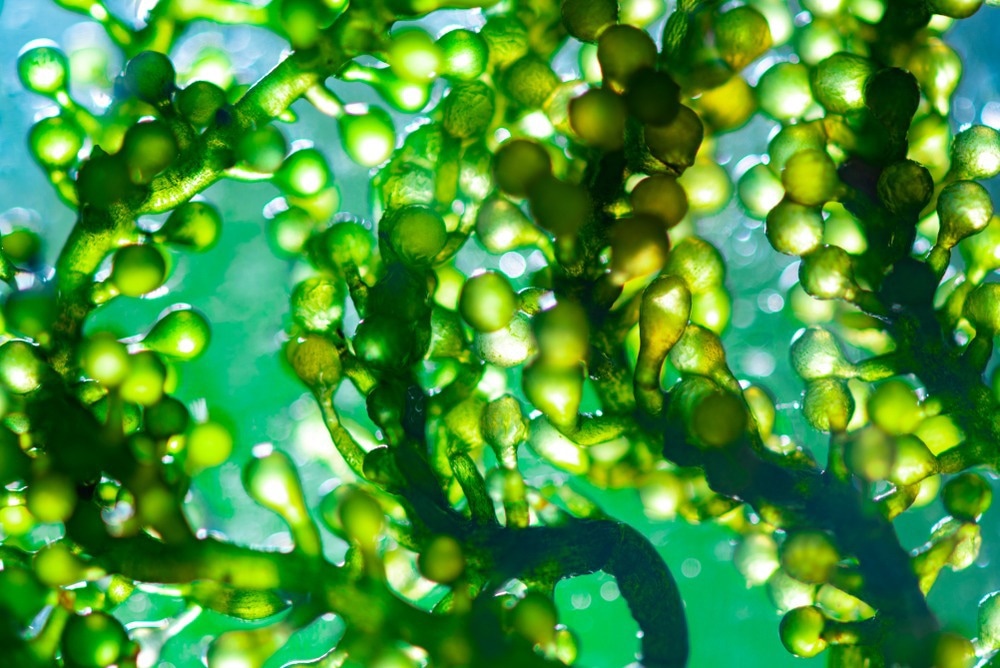Introduction
So Why are Algae So Special?
The Climate Change Problem
Macroscopic Algae and Blue Carbon
A Bio-Energy Reserve?
References
Further Reading
Algae can be utilized as a part of the mitigation strategy to reduce concentrations of carbon dioxide in the atmosphere associated with greenhouse gases and the global climate crisis. Here we discuss what makes algae so special, the global climate crisis, and the part algae can play in helping to combat the effects of global warming.

Algae. Image Credit: Chokniti-Studio/Shutterstock.com
So why are algae so special?
Algae are photosynthetic organisms with plat-like characteristics mainly found in aquatic environments. They are classified Protista and sometimes Plantae, though this latter designation draws controversy. But whatever the taxonomical rank assigned, there is no doubting the enormous significance of these tremendously productive organisms.
There are seven types of algae, categorized based on pigmentation type and food reserves: green algae (Chlorophyta), euglenoids (Euglenophyta) , golden-brown algae and diatoms (Chrysophyta), fire algae (Pyrrophyta), red algae (Rhodophyta), yellow-green algae (Xanthophyta), and brown algae (Paeophyta).
Algae produce a vast quantity (thought to be about half) of the oxygen in the oceans, rivers, and lakes of the world. This feat is miraculously achieved at only roughly 1/10th of the biomass of the entire plant population on Earth. Algae need nitrogen, phosphate, water, CO2 and sunlight for efficient growth.
The main composition of algae comprises carbohydrates, lipids, proteins, carotenoids such as lutein, astaxanthin and fucoxanthin, and nucleic acids. The specific composition is dependent on algal strain and can also be influenced by method of cultivation. Algae possess notable capacities for photosynthesis and thus CO2 sequestration, excessive biomass production, high lipid accumulation and the production of valuable non-fuel co-products.
That algae sequester carbon for growth makes these organisms an invaluable asset in the mitigation of greenhouse gases and climate change and their integral role in our world's oceanic and coastal ecosystems means they are an important blue carbon sink. Research has also demonstrated the superior capacity of algae to produce bioenergy, biofuels, and biomaterials from terrestrial biomass ––most of this a by-product of agricultural or biodegradable waste.
The climate change problem
Climate change refers to shifts in average temperature and weather patterns over time that occurs because of an increase in greenhouse gases in the Earth’s atmosphere. GHG emissions alongside industrialization, ocean acidification, soil erosion and deforestation are all implicated in the process of climate change. The concomitant increase in CO2 levels accounts for more than half of the warming potential.
A solution for the mitigation and reduction of carbon dioxide concentration in atmospheric air is CO2 capture and storage technology. These are divided into physical and biological ––the so-called green technologies. On the biological side, photosynthesis involving the sequestration of CO2 carried out by plants and algae is by far the most environmentally friendly and sustainable solution. This process is fostered through improvements made to natural sinks like forestation, ocean fertilization, and microalgae cultivation.
The Paris Agreement was a 2015 treaty on climate change that called for the removal of carbon from the atmosphere and the lowering of emissions. Since then, the United Nations Framework Convention on Climate Change (UNFCCC) has advocated for cutting carbon levels in order to limit global warming. It aims for less than a 2 °C temperature rise above pre-industrial levels.
A disproportionate amount of carbon sequestration is contributed by coastal vegetated ecosystems and the international community has agreed on a blue carbon initiative. The sequestration of CO2 by microalgae could be one of the most efficient and economical of the technological options available.

Macroalgae plays an important role in carbon sequestration. Image Credit: Citrus deliciosa/Shutterstock.com
Macroscopic algae and blue carbon
Seaweed is a blue carbon sink. This macroalgae sequesters blue carbon and thus represents a climate change solution, although this realization has only been recently made. Not only this but it offers the potential for reducing our reliance on fossil fuels and for regenerative ocean farming with positive implications for future food security.
Blue carbon is organic carbon captured and stored by ocean and coastal ecosystems. Seaweed ecosystems sequester CO2 and contribute to the bioremediation of coastal pollutants and the habitat of other marine organisms.
However, the role of seaweed in blue carbon strategy has been controversial, particularly as, up until recently, researchers believed that seaweed decomposed in the ocean and played no role in the capture of carbon.
Now that it is understood that macroalgae do play an important role in carbon capture, we need to scale up the surface area covered by macroalgal-dominated systems and thus the level of sequestration potential on a global scale.
A bio-energy reserve?
Algae are an attractive source of sustainable energy. Microalgae strains most efficient in CO2 bioconversion for biomass production include Scenedesmus obliquus, Botryococcus braunii, Chlorella vulgaris and Nannochloropsis oculate. Chlorella sp. has also been demonstrated to possess high biomass production (up to 1.06 g L/d).
The ideal species should possess a high sinking capacity and tolerance to various conditions such as CO2 concentration, toxic pollutant levels, temperature, nutrient limitations, and pH effect.
The two types of cultivation systems for algae are open pond (OP) and photobioreactor (PBR). OP is used most frequently in commercial microalgae cultivation. Green photosynthetic algae boast high growth rates and minimal spatial requirements (comparative to plants).
Nevertheless, algal potential in the production of biofuel remains technologically limited at present. It would take a pool three times the size of Belgium to approach just 10% of EU transport fuels.
References
- Chapman, R. 2013. Algae –– The World’s Most Important “Plants”—An Introduction. Mitig Adapt Strateg Glob Change. Doi: 10.1007/s11027-010-9255-9.
- Chew, K. et al. 2020. Algae Utilization and its Role in the Development of Green Cities. Chemosphere. Doi: 10.1016/j.chemosphere.2020.129322.
- Lawrence, M. 2020. How Algae Could Save the World. Sustainability. Online: https://sustainabilitymag.com/sustainability/how-algae-could-save-world.
- Mwaniki, A. 2018. The Major Types of Algae. World Atlas. Online: https://www.worldatlas.com/articles/the-major-types-of-algae.html.
- Vishal, P. et al. 2019. Role of Algae in CO2 Sequestration Addressing Climate Change: A Review. In: Deb et al. (eds.) Renewable Energy and Climate Change. Smart Innovation, Systems and Technologies. Doi: 10.1007/978-981-32-9578-0_23.
- Wilson, Y. et al. 2022. Seaweed: A potential climate change solution. Renewable and Sustainable Energy Reviews. Doi: 10.1016/j.rser.2022.112222.
- Zhao, B. et al. 2014. Process Effect of Microalgal-Carbon Dioxide Fixation and Biomass Production: A review. Renewable and Sustainable Energy Reviews. Doi: 10.1016/j.rser.2013.11.054.
Further Reading
- All Climate Change Content
- How is Climate Change Impacting Our Health?
- Impact of Chocolate on our Climate
Last Updated: Jun 22, 2022

Written by
Dr. Nicola Williams
I’m currently working as a post-doctoral fellow in the History of Science at the Leeds and Humanities Research Institute (LAHRI), at the University of Leeds. Broadly speaking my research area falls within the remit of the history of biology and history of technology in the twentieth century. More specifically I have specialist knowledge in the areas of electron microscopy and cellular and molecular biology, women in science and visual culture.
Source: Read Full Article